
7 Ways Healthcare IT Solutions Improve the Patient Care
The necessity of healthcare IT solutions had got evident during pandemics when access to medical facilities was impossible due to the lockdown. Even after the pandemic, people are more interested in healthcare software than physical visits.
A few top motivators for people to seek medical care through healthcare IT services include how simple it is to schedule and cancel appointments, pay using the payment method of your choice, and track your health with wearables.
Today in this blog, we will put more light on how healthcare IT solutions enhance patient care.
Eager to develop your groundbreaking healthcare software? We’re just one click away!
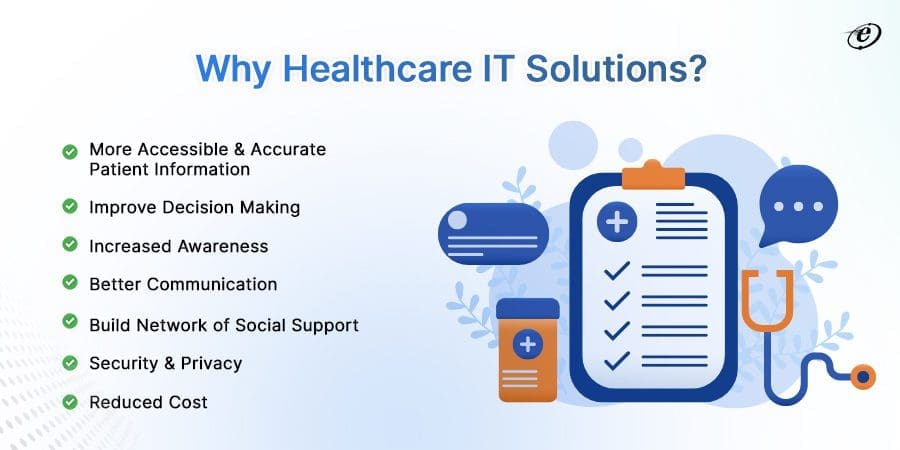
The telemedicine market has expanded considerably in recent years. According to Statista, the global telemedicine market was worth 50 billion dollars in 2019 and is expected to reach almost 460 billion dollars by 2030. Many causes, such as rising traditional healthcare costs, funding for telemedicine, and increased digital health consumers, have contributed to the market’s expansion. The COVID-19 pandemic, however, was the most recent motivator.
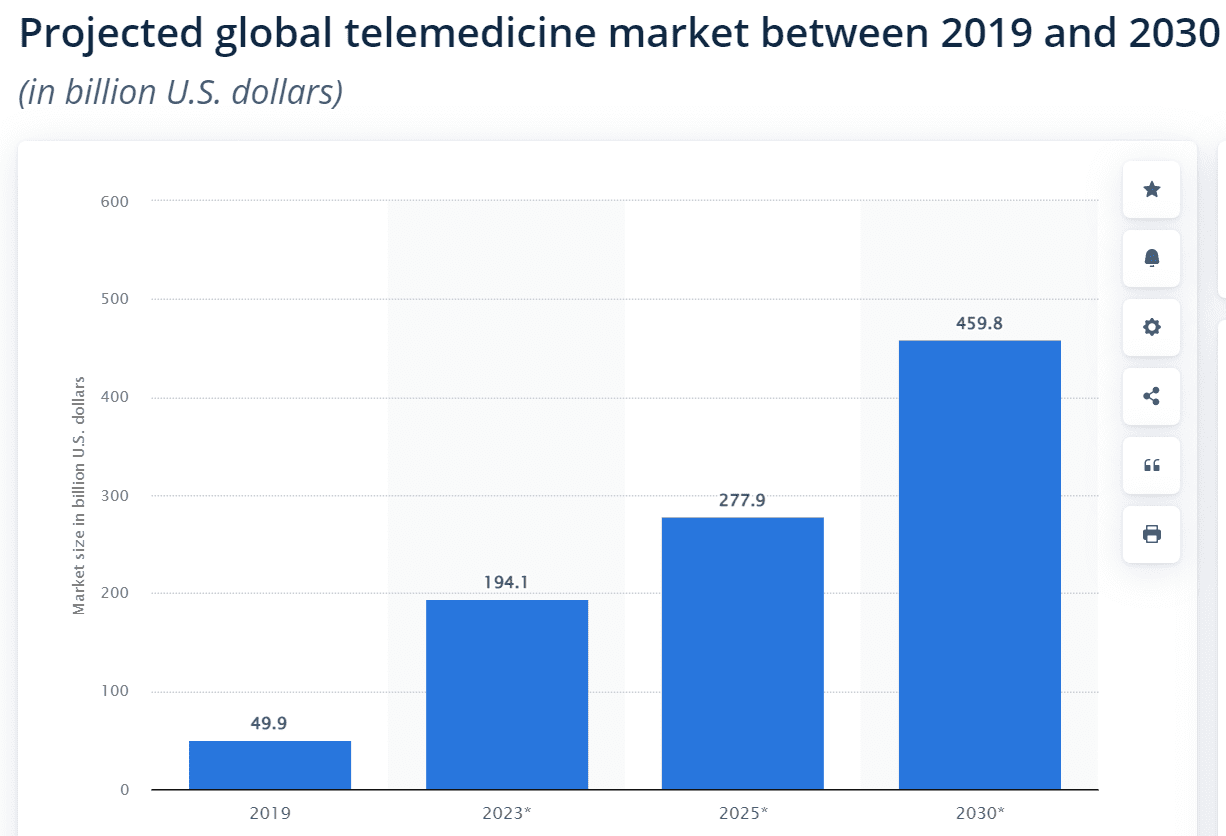
There is no area of healthcare where technology has not impacted. From diagnostic to treatment, both patients and providers are benefiting from technology. Innovative diagnostic methods enable healthcare professionals to detect illnesses earlier than they otherwise would. Many of the inefficiencies and inaccuracies associated with paper-based records are reduced by electronic recordkeeping. Modern tools like artificial intelligence speed up the search for new drugs and help with visual interpretation.
Even after huge technological advancements in healthcare IT services, most of us want to go with the traditional method and are not aware of the telemedicine SWOT and generally, find asking questions to us.
Some of them are:
• What part does technology play in patient care?
• Does it improve the patient experience in any way?
• Does it help relieve the patient illness?
• Is it cost-effective?
There are numerous aspects to take into account while discussing patient care. Today’s patient care is pivotal as top-notch healthcare IT services are replacing traditional procedures to improve access and healthcare quality.
The key-health-tech trends depict that the adoption of IT solutions in healthcare is accelerating in an effort to improve patient care. Let’s examine how technology has improved medical treatment for patients.
What is Healthcare IT Solutions?

The use of information technology (IT) in healthcare is referred to as healthcare IT solutions. Healthcare IT services are used to manage health-related information or issues using technology securely.
Any technology that enables patients to obtain medical care without visiting a doctor is telehealth or IT solutions for healthcare. In other words, any technology that allows safe communication between patients and healthcare professionals across long distances is at the heart of telehealth.

E-prescriptions, electronic health records (EHRs), and other tech tools that assist patients in achieving health objectives like controlling blood sugar levels are some of the top examples of healthcare information technology. EHRs and EMRs have been made possible by information technology, enabling patients to access different healthcare facilities quickly and easily. Additionally, numerous mobile apps, wearables, and information platforms have given patients more control over their health.
Top 7 Benefits of Healthcare IT Solutions for Patients
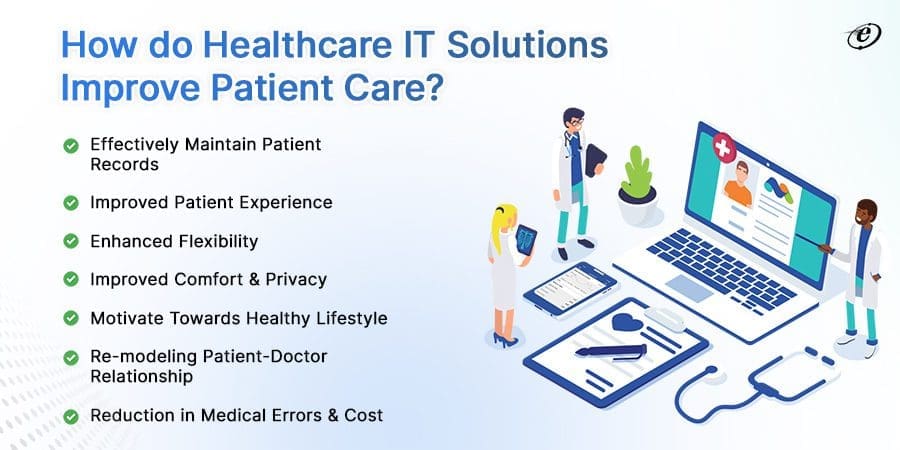
Key benefits of healthcare IT solutions are analyzed across several healthcare sectors as providers continue to increase their usage of healthcare technologies.
Various small and big problems, like sometimes patients struggle to remember to take their medications on schedule, keep their medical data private, promptly renew their prescriptions, and save their medicine orders properly. Healthcare IT innovations offer practical answers to all of these issues. How? Let’s take each one in turn.
1. Effectively Maintain Patient Records
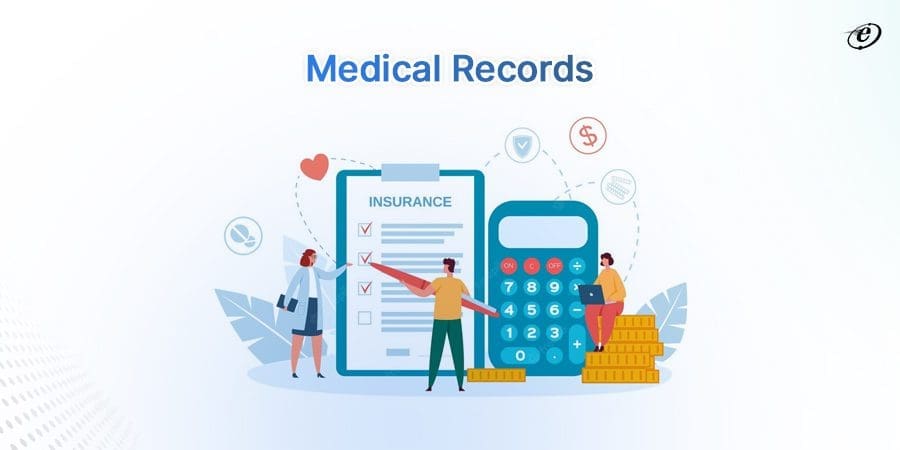
Both patients, and healthcare providers, require access to health records for various reasons. Earlier patient records were tracked using outdated techniques. Many hospitals and other healthcare facilities store their data on paper.
When a patient enters the hospital, it takes a while before the information is accessible to the doctors. Finding the correct file takes time, even for nurses. It becomes challenging to update data and provide a platform when a patient has new conditions.
Healthcare IT solutions developed by leading healthcare IT services providers solve this issue effectively.
How?
Healthcare software allows these files to be digitized and accessed at the click of a button. It is convenient to fill out documentation electronically and easier to find and refer to any given file in the future, with significantly less risk of misplacing any documentation. From doctor scripts to reports and even sick notes, patients and health professionals can soon say goodbye to paper.
With the support of a custom healthcare software development company, any type of customized software can be developed as per patient requirements. On these applications, the information can be accessible at any time and from any location using cloud software and other technologies.
For example, Electronic Health Records (EHR) monitor and facilitate patient records. Medical practitioners can conveniently store data in computer systems with codes.
2. Improved Patient Experience
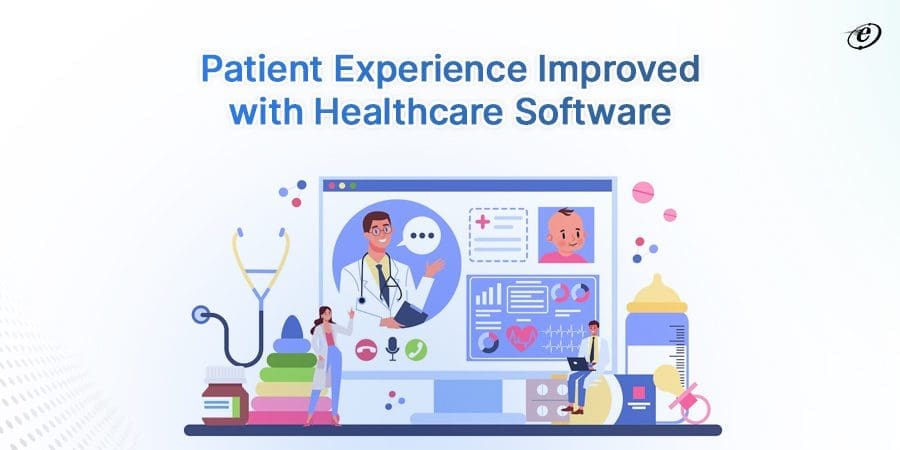
With telemedicine applications, patients can now view their medical history electronically. It has also become simpler to keep track of prescriptions and symptoms. Due to this systematic process, users can find the right healthcare specialists and their advice as needed.
Instead of waiting until their illness worsens, virtual visits urge individuals to get in touch with their healthcare practitioner more frequently and earlier. A variety of telehealth options can help manage chronic diseases, adhere to medicine, monitor health conditions, and stick to treatment protocols in addition to virtual encounters.
Since so many alternative healthcare options are accessible, hence patient experience has become crucial. Every medical care provider has understood that customer satisfaction is a universal ingredient for success.
To guarantee patient satisfaction, speed and efficiency are essential; as a result, features like rapid access to medical records and treatment histories are incorporated into healthcare IT Solutions, further enhancing the patient experience.
These types of advances are creating wide-ranging opportunities in the healthcare sector. Everything is managed by a systematic process, from medical facilities delivery to patient data.
3. Enhanced Flexibility
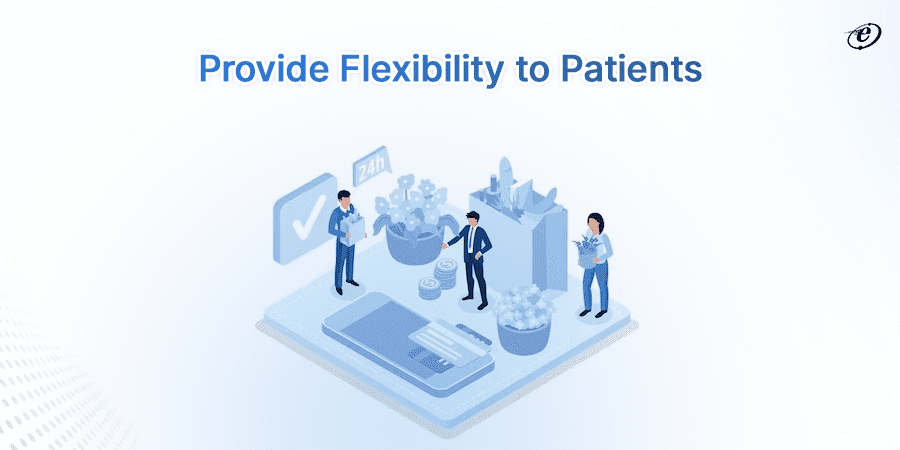
With digitization, most tasks are being automated. For both patients and healthcare professionals, this saves time and money. Today’s healthcare sector makes fewer mistakes and produces successful results.
In this busy lifestyle, finding time for appointments can be challenging as patients are frequently busy. Healthcare IT services have provided more communication channels with medical practitioners through patient portals. Better diagnosis and greater quality care are available through electronic medical records. This significant transformation in healthcare guarantees better care.
In addition to giving clinicians more means to assess their patients’ health, wearable technology like digital monitors also gives them great opportunities to record and analyze the symptoms of patients.
Before the development of telemedicine, doctors could only treat patients in person within predetermined office hours. Now patients can consult with healthcare professionals through digital applications anytime and from any location.
Without having to be in the office, doctors can do virtual visits on their days off or during their on-call shifts. Due to this flexibility, patients can schedule appointments with their preferred practitioners easily and quickly.
4. Improved Comfort & Privacy
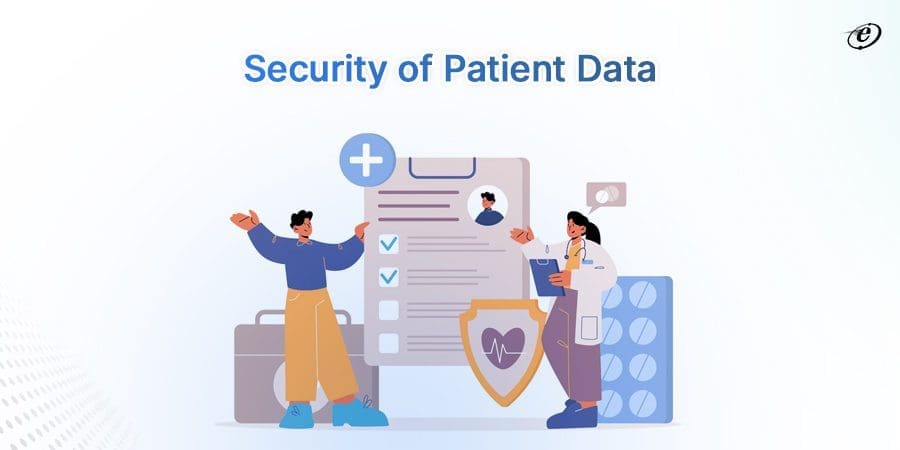
The healthcare industry has significantly changed since the introduction of IT services. Patients can monitor their health, and clinicians can easily access patient records to look up information.
People frequently relocate to new towns and locations, necessitating the use of various healthcare professionals. Throughout one stay, patients receive care concurrently from a variety of professionals.
Moreover, a person may get hurt while traveling and end up being carried to the nearby hospital, which does not have any records of the new patient. Then it will be quite risky to give any medication to him without knowing any allergies. In that case, the patient’s digital records will help in providing the right medical care. Health informatics enables coordination by incorporating healthcare professionals and patient care in the recording, sharing, and disseminating of the records.
The top-notch healthcare IT services provided by experienced custom healthcare software development companies connect and share EMRs safely and swiftly.
Only one concern you might have, patient electronic medical records (EMRs) are a treasure trove of private data, and hackers will stop at nothing to obtain access to it.
But you need not have to worry. Government organizations like the HIPAA frequently update federal laws to guarantee that healthcare security is advancing.
The best IT outsourcing partner can help cover all these facets. Explore our services for more information.
5. Motivate Towards Healthy Lifestyle

By routinely recording symptoms and monitoring health issues, IT solutions for healthcare assist people in managing their diseases. More importantly, it is a tool for the early diagnosis of substantial changes in a patient’s condition before health has been severely compromised.
One safe online tool is the Patient Electronic Portal, which enables two-way electronic contact between patients and their healthcare providers from a computer or mobile device.
Latest technologies like AR and VR increase patient engagement by enabling patients to view medical operations using 3D models. Similarly, smart wearable technology can collect information regarding patient ailments, allowing medical professionals to examine them and take preventative action.
Patients can receive pill reminders from several digital health solutions via SMS, push notifications, or emails. Patients will never forget to take their prescriptions on time this way. Sometimes people neglect to refill their prescriptions. To address this, healthcare apps such as pharmaceutical delivery applications, doctor applications, and hospital applications prompt patients to fill their prescriptions.
6. Re-modeling Patient-Doctor Relationship
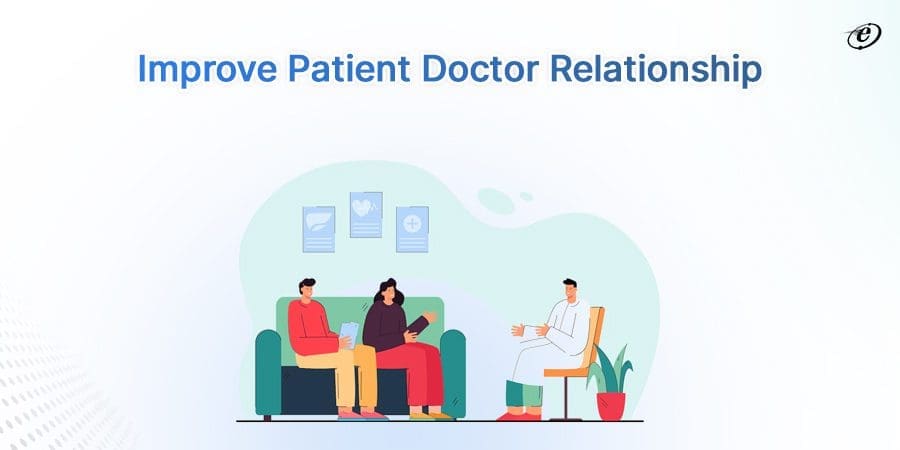
A study on systematic delivery of healthcare services research on the full implementation of digital technology in healthcare mentioned how digital technologies like AI and robotics help the patient’s rehabilitation and recovery. As per the report, one of the most efficient digital healthcare trends for developing patient-individualized treatment plans is using standardized consultation templates.
Healthcare professionals are adopting technologies that can assist in better educating and engaging patients because it plays a crucial role in patient care. Through healthcare IT solutions, individuals can receive personal healthcare education information based on their requirements and situations.
With the help of these solutions, medical personnel may centralize and access a patient’s data. Thus, the difficulties frequently accompanying developing and carrying out tailored treatment plans are greatly diminished.
Specialists can monitor patients’ health more effectively, including their compliance with treatment programs. This is crucial for seniors and those living alone since it ensures that their family members or concerned healthcare professionals will be notified immediately if any issue is found. As a result, these technology tools guarantee that patients receive first-rate care, improving the accessibility and standard of care for everyone.
7. Reduction in Medical Errors & Cost
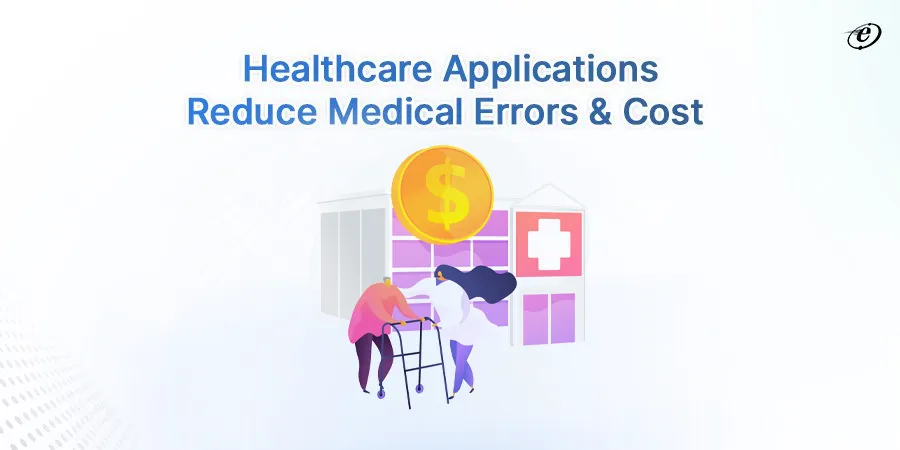
Medical error is one of the biggest public concerns and is the 3rd greatest cause of death. According to the American Institute of Medicine (IOM), around 98,000 people die yearly due to medical errors. These errors occur frequently and are an inevitable aspect of human performance.
Fortunately, healthcare IT services have aided in creating digital solutions that have been shown to lower medical errors and increase lifesaving. This information is timely filtered and provided at the relevant times in order to aid the healthcare professional’s decision-making.
By leveraging IT services for healthcare, we can reduce prescription and diagnosis errors to a great extent. Direct savings for patients and practitioners result from a decrease in medical errors.
A cloud EMR drastically minimizes the expense of other errors and the utilization of paper in clinical settings. While switching from paper to a medical EMR at a clinic can save outpatient care expenses by 3%. According to estimates, each patient will save $5.14 per month as a result.
In a Nutshell
Information technology has undoubtedly revolutionized the healthcare sector. There are now numerous healthcare IT solutions at our disposal that can improve patient care. The benefits mentioned above are proof of it.
All across the world, digital technology is being used in the medical and healthcare sectors. Many hospitals, clinics, drug companies, and other healthcare facilities are switching to an entirely digital style of operation and commerce.
Patients also prefer healthcare providers that are available online and can be consulted easily. The ability to track health and locate required health records immediately and accurately encourages users to move to digital healthcare applications.
Thus, if you are running healthcare or telemedicine services, you must move to a digital platform to stand ahead of your competitors. You can take the help of a custom healthcare software development company that can create user-friendly technological solutions to optimize patient care and improve productivity.
Stop waiting. Book your free consultation and benefit from our healthcare software development expertise.



